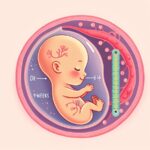The journey into the second trimester of pregnancy, starting at week 13, marks a significant milestone in the development and growth of both the baby and the expectant mother. This period, often referred to as the ‘honeymoon phase’ of pregnancy, brings about numerous changes and developments that are crucial for the baby’s growth and the mother’s well-being. In this comprehensive guide, we’ll explore what starts at week 13, delving into the specifics of fetal developments, maternal changes, and tips for navigating the second trimester effectively.
Second Trimester: What starts at week 13?
The second trimester is often associated with a significant decrease in early pregnancy symptoms such as nausea and fatigue, making it a more comfortable phase for many women. But what exactly starts at week 13 that differentiates it from the first trimester? Let’s unravel the developments and changes that commence as you step into this new phase.
One of the most notable changes during the second trimester is the visible growth of the baby bump, as the uterus expands to accommodate the growing fetus. This period also marks the start of several key fetal developments. The baby’s organs continue to mature, and by the end of the second trimester, the fetus will have fully formed fingers and toes, distinct facial features, and the ability to hear sounds from the outside world. Additionally, this is the time when many parents can find out the sex of their baby through ultrasound scans.
Maternal Changes and Health Tips
As the baby grows, expectant mothers will also notice several changes in their own bodies. Aside from the growing belly, women may experience increased appetite, heightened energy levels, and improved mood compared to the first trimester. However, the second trimester also introduces new challenges, including the risk of gestational diabetes and the onset of back pain due to the increasing weight of the uterus.
It’s crucial for expectant mothers to continue receiving prenatal care, maintain a balanced diet rich in vitamins and minerals, and engage in regular, moderate exercise. Staying hydrated, practicing prenatal yoga, and wearing supportive footwear can also alleviate some of the discomforts associated with this phase. For more detailed guidance on managing your health during the second trimester, consider exploring articles on [safe herbal teas during the second trimester](https://babywhysandhows.com/safe-herbal-teas-during-the-second-trimester) and [nutritional needs for twin pregnancy](https://babywhysandhows.com/nutritional-needs-for-twin-pregnancy).
Fetal Development Milestones
During the second trimester, the fetus undergoes a remarkable period of growth and development. By week 13, the fetus’s organs, muscles, and nerves start functioning together. The skeletal system continues to ossify, turning cartilage into bone, laying the foundation for strong bones. The development of the circulatory and urinary systems also progresses, with the fetus beginning to produce urine, contributing to the amniotic fluid.
Another significant milestone is the development of the fetal nervous system. By the end of the second trimester, the baby’s brain will have formed billions of neurons, establishing the neural connections necessary for future sensory experiences. This period also sees the onset of fetal movements, often described as flutters by expectant mothers. For a closer look at fetal development during this stage, you might find the article on [fetal development milestones at 12 weeks](https://babywhysandhows.com/fetal-development-milestones-at-12-weeks) insightful.
Preparing for the Rest of Your Pregnancy
As you navigate through the second trimester, it’s also an excellent time to start preparing for the rest of your pregnancy. This includes planning for maternity leave, setting up the nursery, and considering prenatal classes. Engaging in discussions about birthing plans and exploring options for labor and delivery can also provide comfort and confidence as the due date approaches.
Moreover, the second trimester is an ideal time to bond with your baby. Talking, reading, and even singing to your baby can be beneficial, as they are now able to hear sounds from the external environment. For tips on creating a nurturing bond with your unborn child, explore the benefits highlighted in our article on [the importance of music for fetal development](https://babywhysandhows.com/the-importance-of-music-for-fetal-development).
In conclusion, the second trimester is a period of significant growth, development, and preparation. By understanding what starts at week 13 and beyond, expectant mothers can take proactive steps to ensure a healthy and enjoyable pregnancy journey. Remember, every pregnancy is unique, so it’s essential to consult with healthcare providers for personalized advice and support.













